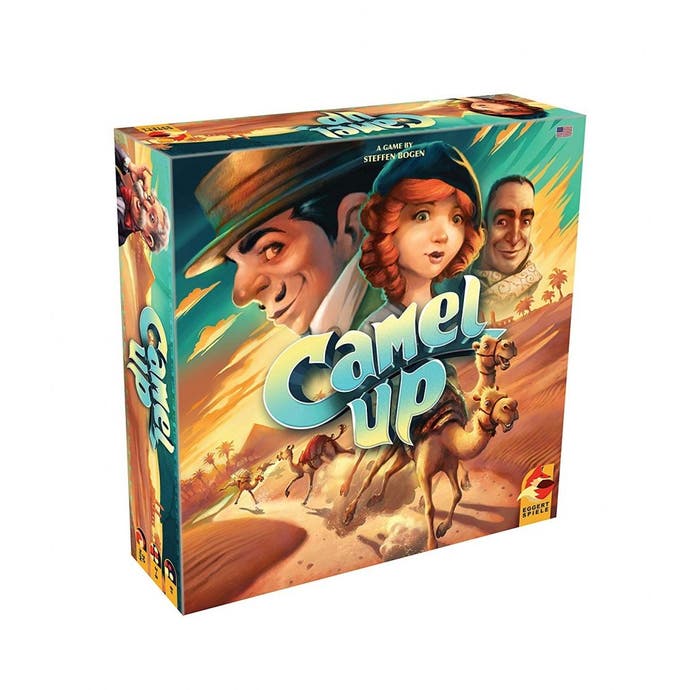Dicebreaker Recommends: Camel Up: Second Edition, a game you can bet on for a good time
It won't give you the hump.
Dicebreaker Recommends is a series of monthly board game, RPG and other tabletop recommendations from our friends at our sibling site, Dicebreaker. Don't forget to also check-out their list of the best board games to play in 2023.
When I was younger, my parents used to invite my brother and me to bet on the Grand National - a renowned British horse race - with 20p being the maximum amount we could put into the pot. Despite the minuscule amount of money at stake, and the fact that I now find races like the Grand National to be rather cruel, it was impossible not to feel a certain rush whenever I handed over my 20 pence piece in hopes that Cloudy with a Chance of Meatballs, or whichever oddly named nag I'd chosen, would help me win big. I still experience this exact same feeling whenever I play Camel Up: Second Edition.
I'm not a fan of actual gambling - both because it can be used to prey on vulnerable people and I couldn't possibly afford to do it myself - but I do enjoy games that simulate certain parts of it. Push-your-luck games like Clank! and Can't Stop provide opportunities for players to feel like they're testing the odds, but without any of the potentially terrible consequences that real-life gambling could have. Camel Up: Second Edition does much the same thing, with players able to make fictional bets on fictional camel races and still feel something akin to the kind of youthful excitement I felt back in my Grand National days.
The second edition of Camel Up is much like the first, with players able to take betting tickets on each colour of camel and earning coins whenever they've bet on the correct winner of a round. Perhaps the biggest difference that Camel Up: Second Edition brings - besides aesthetic changes - is the addition of two new colours of camel, black and white, which move backward around the track with the purpose of causing the most amount of chaos possible.
Camel Up features a collection of dice, with each one corresponding to the matching camel meeple on the board, except for a grey die that controls both the black and white camels. On their turn, a player can choose to pull a random die from the plastic pyramid in the middle of the board, with the number indicating how many spaces that corresponding camel moves. The maximum number that can be rolled on any of the dice is three, meaning that players can attempt to determine whereabouts they think a camel might move each round.
However, whenever a camel meeple lands on the same space as another it is placed on top to form a stack. Should a camel in a stack ever move, it takes all the camels on top of it with it as well. This detail is important because whichever camel is on top of a stack is technically ahead of those on the bottom. Camel stacks can disrupt the expected results of each round in all sorts of ways, with the backwards camels only increasing the chances of disruption whenever a normal camel happens to land on top of one.

Predicting the result of each round is the main thing you'll be doing in Camel Up, as winning requires having the most plastic money by the game's end. Coins can be won by taking the ticket tokens of a round's winning camel, alongside placing bets on the race's overall winner and loser. You also gain a coin whenever you roll a die, which is a nice little incentive to keep the game's pace moving, even at the cost at providing more information for your opponents. But even if someone thinks they know which camel is going to win a round or even the entire race, Camel Up's capacity for chaos almost guarantees that something won't turn out the way they think it will.
Players can attempt to push the outcome of the race in their favour by placing tokens on the racetrack to force a camel to move a space forward or backwards (as well as gain them a coin every time a camel lands on their token). The camel-stacking and token-placement elements of Camel Up both make it very difficult for a player to game the system. Players can certainly compare the odds of something happening, but I've not taken a betting ticket before because it seemed unlikely that a certain outcome would occur only to witness that exact thing happen mere seconds later.
But playing Camel Up isn't really about comparing odds and measuring probabilities. The addition of the backwards camels and the amazing pop-up palm tree in the game's second edition should make it abundantly clear that this is ultimately a board game about having fun above all else. Players are rewarded for taking risks, even with very little information to back them up - such as placing early bets on the game's overall winner and loser - because the game wants you to throw caution to the wind. And what better way to indulge such reckless behaviour than playing with plastic coins in a board game about a fictional camel race?
Camel Up: Second Edition really is the most wholesome form of risk-taking there is, which is why it's a fantastic game to play with anyone of pretty much any age.










